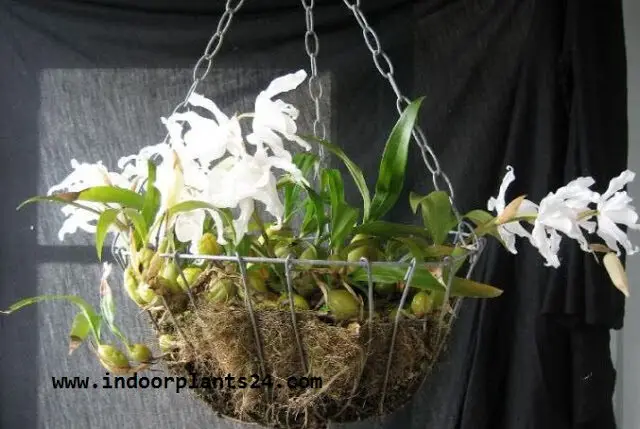06:26 This orchid produces two strap-shaped, slightly arching leaves from each of the rounded or egg-shaped pseudobulbs, which are tightly clustered. Flower stalks some 12in/30cm long arise from the pseudobulbs in winter or early spring and carry 6-8 scented white flowers with golden yellow markings on the lip, and undulating petals. 


Coelogynes are not the easiest orchids to grow in the home. They require high humidity during the growing season and a short winter rest period in order to produce their flowers.  The pure white-and-gold flowers are, however, carried in quite large numbers on established plants, making coelogyne’s cultivation a tempting prospect. It grows well mounted on a log or bark or in a hanging wooden basket, where its long, drooping flower stems will show to best advantage.
The pure white-and-gold flowers are, however, carried in quite large numbers on established plants, making coelogyne’s cultivation a tempting prospect. It grows well mounted on a log or bark or in a hanging wooden basket, where its long, drooping flower stems will show to best advantage.  FACT FILE
FACT FILE
ORIGIN Himalayas.
HEIGHT To 12in/30cm.
POTTING MIX Use only special orchid mix, which may consist of shredded bark, tree-fern fiber, and sphagnum moss.
REPOTTING In spring every 3-4 years. The plant resents disturbance.  PROPAGATION Cut off part of the rhizome together with a small number of pseudobulbs and pot up in special orchid mix.
PROPAGATION Cut off part of the rhizome together with a small number of pseudobulbs and pot up in special orchid mix.
KEEPING PLANTS With proper care, this orchid will last for many years.
COELOGYNE CRISTATA Orchidaceae EOELOGYNE PLANT CARE

- Bright filtered light at all times.
- Minimum winter temperature of 55°F/13°C during the day, 45°F/7°C at night. In summer, keep temperatures below 75°F/24°C.
- To water, stand plants in water for 10 minutes. Always keep the soil moist in the growing period.
- During the rest period, water just enough to prevent the soil from drying out completely.
- Mist the foliage regularly to ensure high humidity.
- Apply a foliar feed every 2 to 3 waterings.
- A 6-week winter rest period is essential to ensure good flowering.
 Pseudobulbs become wrinkled and yellow after flowering, but the new ones are shiny and light green. Take care not to splash the pseudobulbs when watering.
Pseudobulbs become wrinkled and yellow after flowering, but the new ones are shiny and light green. Take care not to splash the pseudobulbs when watering.
- Share
- Share
- Share
- Share
